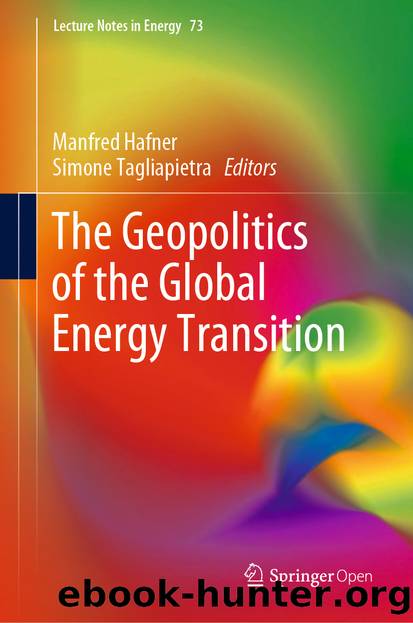The Geopolitics of the Global Energy Transition by Unknown

Author:Unknown
Language: eng
Format: epub
ISBN: 9783030390662
Publisher: Springer International Publishing
2.4 Carbon Capture, Utilization, and Storage
Another technological solution that may play a significant role in the decarbonization of the power sector is the carbon capture, utilization and storage (CCUS), aiming at complementing power plants based on combustion, both for fossil fuels and eventually for bioenergy (BECCUS), to reach net negative emissions. Different technologies and concepts are available.
The first projects related to CCS were aimed at exploiting the carbon dioxide to enhance oil recovery in depleted reservoirs. Since the first large-scale facility, which dates back to 1972, almost one hundred CCS facilities and nine test centers worldwide have started up or begun construction (Global CCS Institute 2018). These projects generally involve the post-combustion separation of the CO2, with removal efficiencies around 90%, and require additional power consumption and a dedicated infrastructure for the transport of the gas to the storage site. Transport and storage risks are among the causes leading to a low public acceptance of these projects, which appears to be higher when carbon dioxide is reused instead of sequestrated (Arning et al. 2019).
Many alternative solutions are being proposed for CO2 utilization. Sometimes referred to as carbon-to-value, CCU includes the multiple technologies that allow to recycle the carbon dioxide stream obtained by flue gases or air to manufacture a range of products, including cement, carbonates, chemicals, plastics, and synthetic fuels. The aim of these processes is to find an alternative to CCS, by overcoming the concept of burying carbon emissions underground and providing effective value by creating market products that would have consumed other resources for their production. In some cases, e.g., when producing fuels, the carbon dioxide is released again into the atmosphere, but the entire cycle is (almost) carbon-neutral. There is a growing interest in CCU applications worldwide, and some companies are already providing commercially competitive solutions, although often at limited scale.
While the previous concepts are generally coupled to the combustion flue gases of thermoelectric power plants, another technology still in early maturity is gaining interest in the scientific community: direct air capture (DAC). The idea of DAC is to use specific solutions, including membranes, to capture the CO2 directly from the concentration in the air. This would allow a broader flexibility in locating the facility. One of its main challenges is related to its significant energy consumption, although experts are confident it can become cost-competitive with other CO2 capture technologies if massively deployed (Fasihi et al. 2019). Another limitation appears to be the rate at which this technology can be scaled up (Realmonte et al. 2019).
Download
This site does not store any files on its server. We only index and link to content provided by other sites. Please contact the content providers to delete copyright contents if any and email us, we'll remove relevant links or contents immediately.
International Integration of the Brazilian Economy by Elias C. Grivoyannis(90693)
The Radium Girls by Kate Moore(11921)
Turbulence by E. J. Noyes(7935)
Nudge - Improving Decisions about Health, Wealth, and Happiness by Thaler Sunstein(7615)
The Black Swan by Nassim Nicholas Taleb(7010)
Rich Dad Poor Dad by Robert T. Kiyosaki(6398)
Pioneering Portfolio Management by David F. Swensen(6226)
Man-made Catastrophes and Risk Information Concealment by Dmitry Chernov & Didier Sornette(5921)
Zero to One by Peter Thiel(5684)
Secrecy World by Jake Bernstein(4640)
Millionaire: The Philanderer, Gambler, and Duelist Who Invented Modern Finance by Janet Gleeson(4374)
The Age of Surveillance Capitalism by Shoshana Zuboff(4209)
Skin in the Game by Nassim Nicholas Taleb(4161)
Bullshit Jobs by David Graeber(4094)
The Money Culture by Michael Lewis(4073)
Skin in the Game: Hidden Asymmetries in Daily Life by Nassim Nicholas Taleb(3929)
The Dhandho Investor by Mohnish Pabrai(3698)
The Wisdom of Finance by Mihir Desai(3649)
Blockchain Basics by Daniel Drescher(3495)
